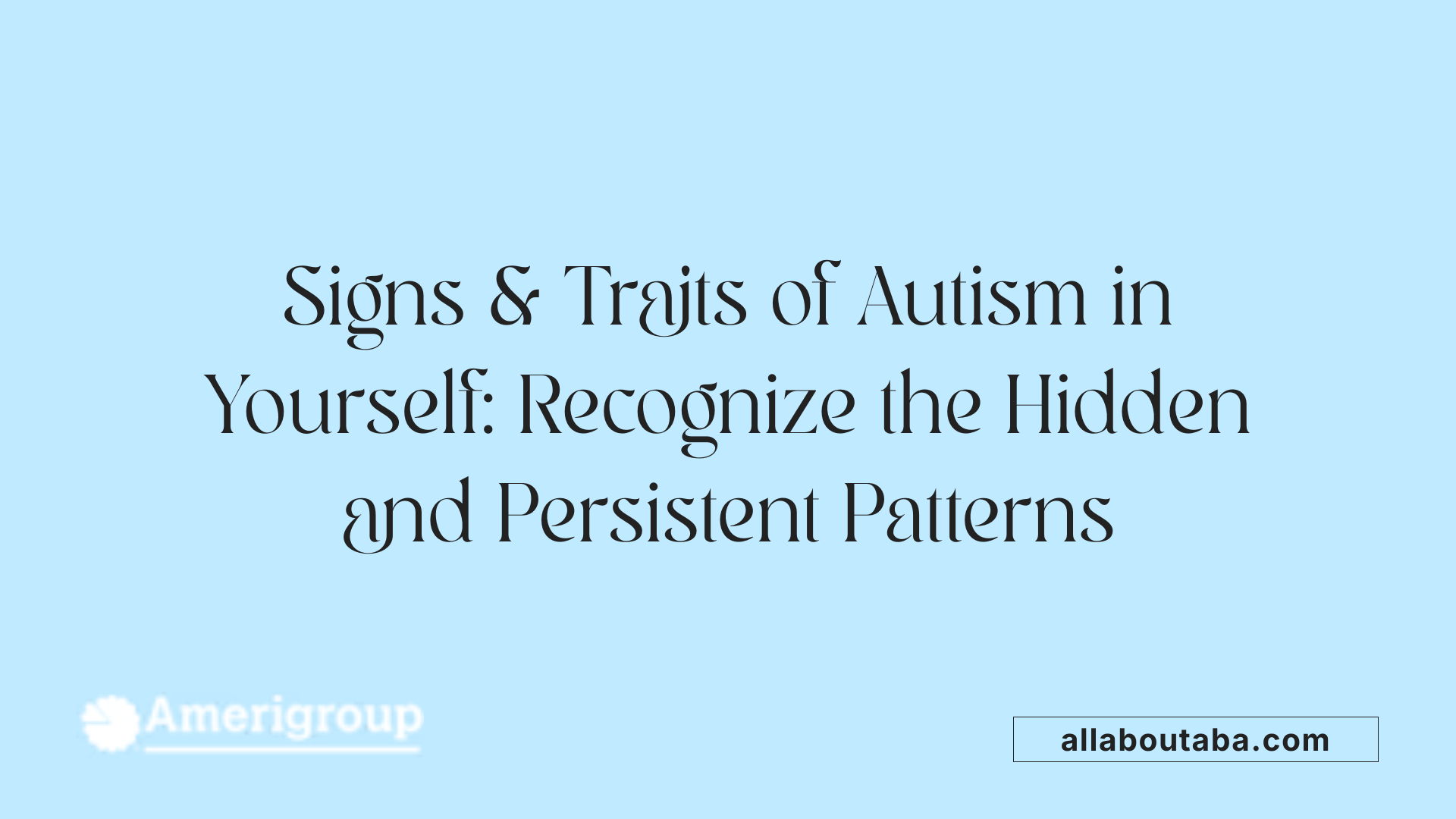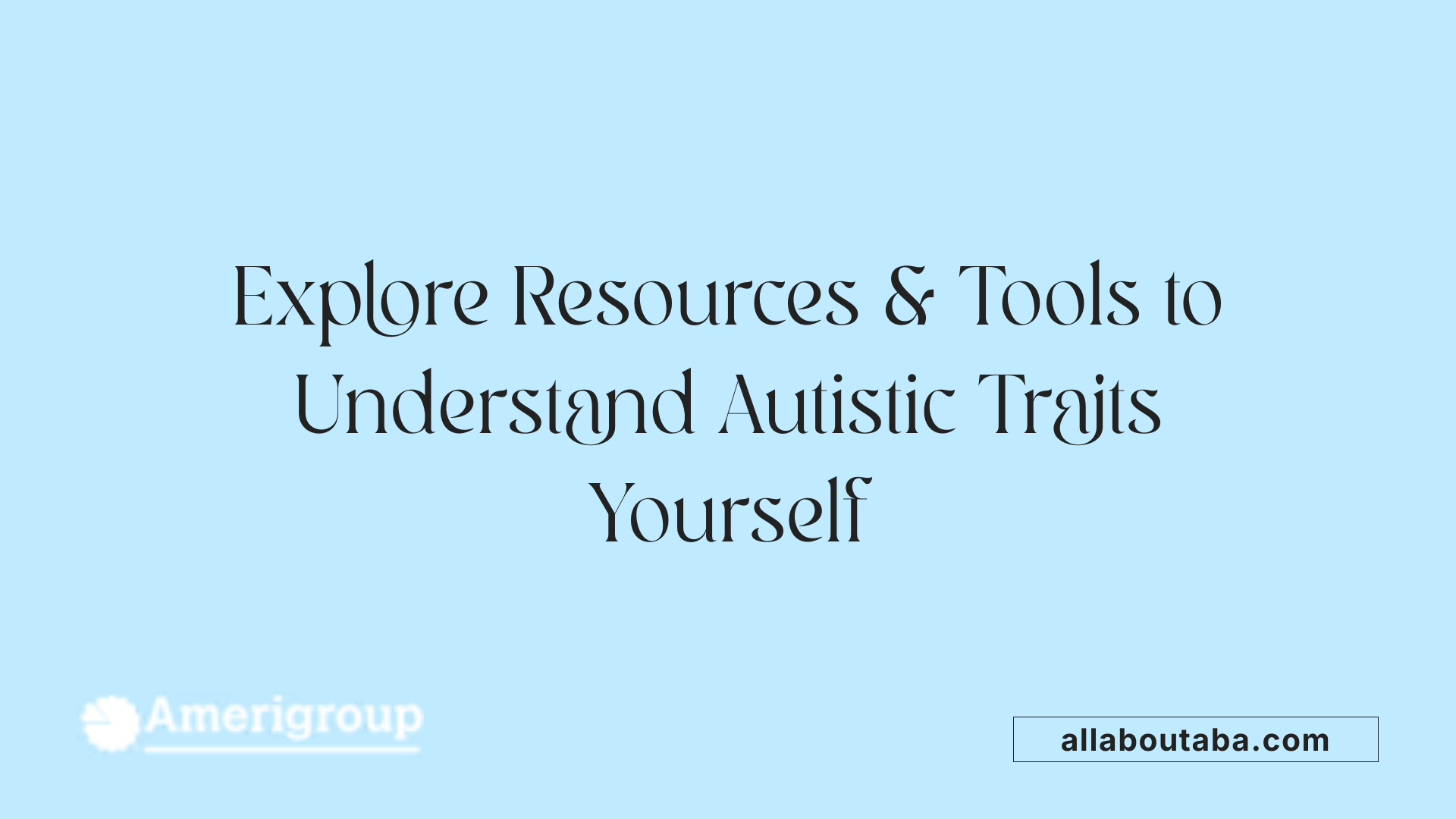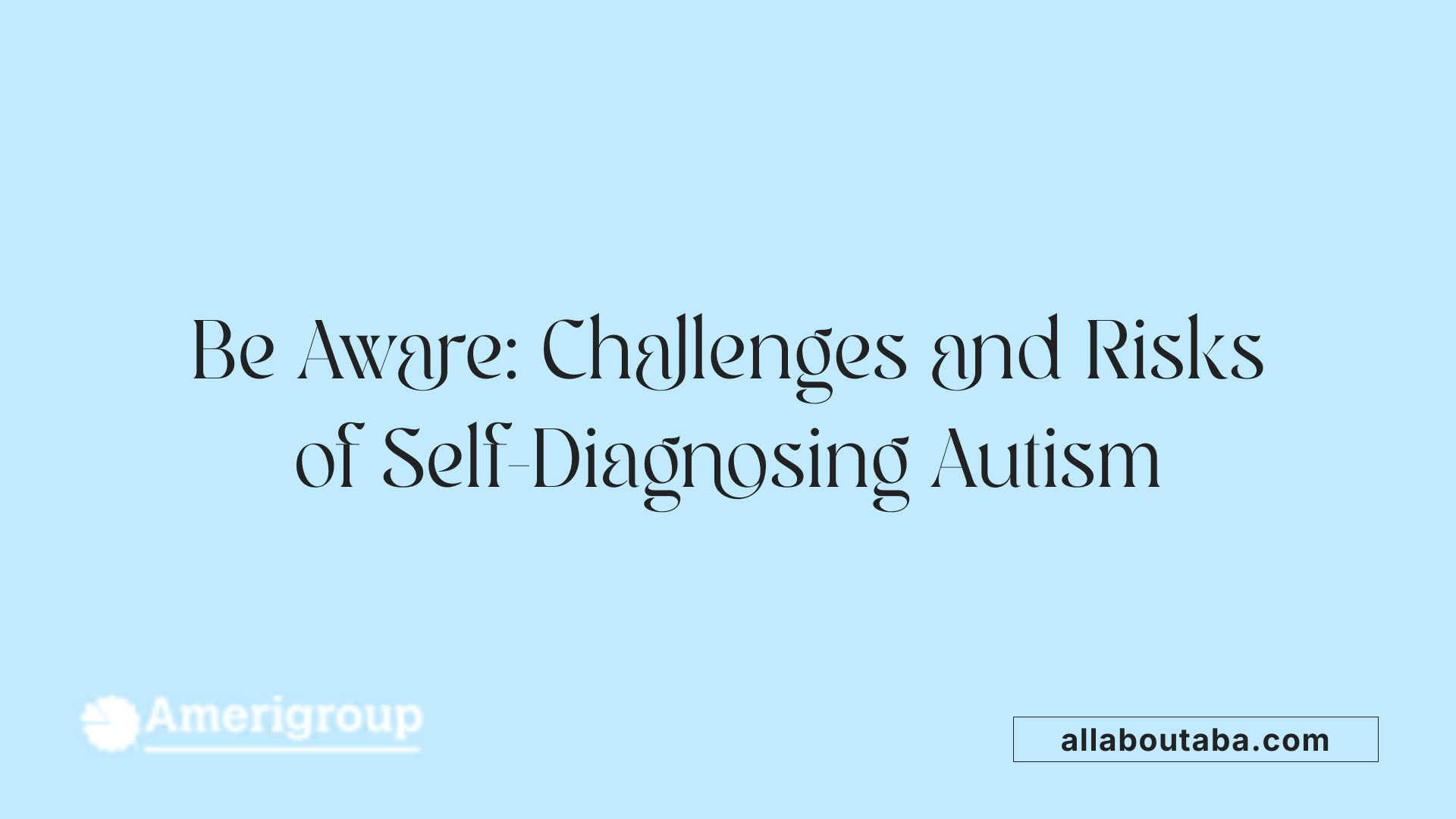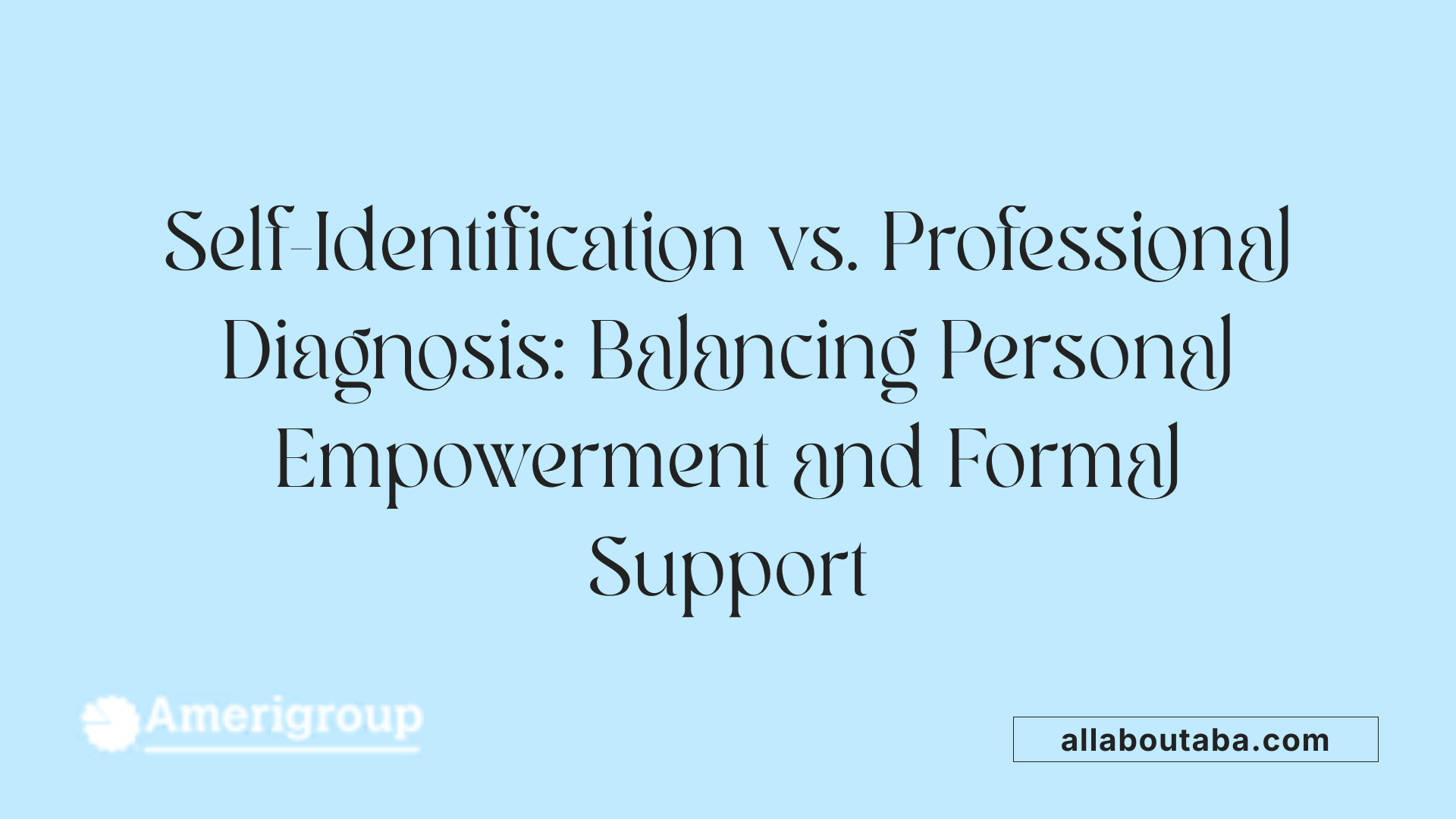Exploring the Growing Phenomenon of Self-Diagnosis
In recent years, there has been a significant rise in individuals self-identifying as autistic without formal medical diagnoses. This trend is driven by increased awareness, barriers to access, and the proliferation of online information. While self-diagnosis can serve as an empowering step toward self-understanding, it also brings challenges related to accuracy and support. This article delves into the complexities of self-diagnosed autism, examining its validity, the resources available, and the importance of professional evaluation.
Recognizing Autism in Oneself: Signs, Traits, and Hidden Factors

How do I recognize autism in myself?
Self-recognition of autism involves paying close attention to certain persistent behaviors and feelings that may suggest the presence of autism spectrum disorder (ASD). Many individuals notice challenges in understanding social cues, such as difficulty interpreting facial expressions, body language, or tone of voice. You might find it hard to grasp social rules, like knowing when to take turns in conversation or how to respond appropriately in social settings.
Repetitive behaviors and intense interests are common signs. These can include engaging excessively with specific topics or hobbies, or having routines and rituals that provide comfort and predictability. Sensory sensitivities are also important indicators; if loud noises, bright lights, or certain textures cause discomfort or overwhelm you, this could be a sign of autistic traits.
Communication difficulties are another key aspect. You may struggle with understanding idioms, sarcasm, or jokes, which can make social interactions confusing or frustrating. Some autistic individuals experience challenges in expressing their feelings clearly or may feel misunderstood.
It’s also notable that many autistic women and girls tend to mask or hide their traits. They might appear quieter, more socially adaptable, or try to imitate their peers to blend in. This masking can obscure recognition, making it harder for both the individual and others to notice autism.
Feeling different from others or having ongoing difficulties in maintaining friendships can signal autism, especially if these feelings persist despite effort or support. Persistent feelings of loneliness, misunderstandings in social situations, or a sense of not fitting in are common among autistic individuals.
If you find that several of these signs resonate with your experiences, consider seeking advice from a healthcare professional. An expert can conduct proper assessments and provide support tailored to your needs. Keep in mind that self-awareness is a vital step, but a formal evaluation can offer clarity and access to additional resources.
Understanding these traits can help you better navigate your experiences and connect with communities and support systems that recognize and validate your identity. Whether you pursue a formal diagnosis or simply want to understand yourself better, acknowledging these signs is an important part of your personal journey.
Tools, Resources, and Support for Self-Diagnosis

Are there resources or tools for autism self-diagnosis?
Yes, there are a variety of resources and tools available that can help individuals explore the possibility of autism on their own. Several online screening questionnaires, such as the Autism Spectrum Quotient (AQ), the Ritvo Autism Asperger Diagnostic Scale-Revised (RAADS–R), and others, are designed to identify traits associated with autism. These tools are not diagnostic on their own but can serve as helpful indicators for people who are curious about their neurodevelopmental profile.
Organizations like the University of Washington Autism Center and Milestones Autism Resources offer accessible educational materials, checklists, and community connections tailored to support self-exploration. These resources often include detailed guides on understanding autistic traits, practical tips for managing challenges, and ways to connect with others sharing similar experiences.
Self-assessment tools and online questionnaires empower individuals to undertake thorough personal research and reflect on their behaviors, sensory sensitivities, social interactions, and cognitive styles. Engaging with these tools can foster greater self-awareness and help individuals understand if their traits align with autistic profiles.
However, it’s important to recognize the limitations of online self-assessment without professional backing. While these tools can suggest the possibility of autism, they do not replace comprehensive evaluations conducted by qualified healthcare professionals. Diagnosing autism requires a detailed assessment that involves developmental history, behavioral observation, and sometimes formal testing.
Reputable organizations such as Autism BC and Milestones Autism Resources play a significant role in providing validated information, community support, and advocacy. They offer resources that help individuals learn more about autism, reduce stigma, and find local or online groups for connection and support.
Ultimately, thorough personal research, combined with engagement in community and educational initiatives, can support self-identification. It can help individuals understand themselves better and find supportive networks. Still, obtaining a formal diagnosis remains critical for access to individualized supports, specialized therapies, and legal protections. Consulting healthcare professionals for evaluation is recommended if one chooses to pursue official recognition.
In summary, although self-diagnosis is supported within the community and facilitated by various tools and resources, it should be complemented with professional assessment for those seeking formal validation or support. Resources like questionnaires, community organizations, educational materials, and reputable advocacy groups collectively empower individuals in their journey of understanding their neurotype and advocating for themselves.
Genetics and Environmental Influences on Autism
What is the genetic contribution to autism?
Autism spectrum disorder (ASD) has a notably strong genetic component. Scientific research estimates that genetic heritability ranges widely but typically falls between 50% and 90%. For example, studies conducted on Swedish cohorts have suggested that heritability could be as high as approximately 83%. This means that genetics plays a major role in determining whether an individual might develop autism.
Scientists have identified hundreds of genes associated with autism, many of which are vital for normal brain development, neural connectivity, and synaptic functioning. Some of these genetic changes are inherited from parents, passing down through generations, while others are spontaneous mutations that occur de novo. These new mutations often link to increased paternal age at conception, highlighting how parental factors can influence genetic risks.
Twin studies serve as a crucial source of evidence for the genetic basis of autism. These studies often show higher concordance rates among monozygotic (identical) twins—ranging from 70% to 90%—compared to dizygotic (fraternal) twins. The stark difference in these rates underscores the significance of genetics but also acknowledges that environmental factors are at play.
Certain genes have been pinpointed as notable contributors to autism risk. Examples include CHD8, SCN2A, and SHANK3, each involved in crucial aspects of brain functioning. Mutations or variations in these genes can influence neural development and synaptic signaling, pathways often disrupted in autism.
While genetics form the core of autism susceptibility, environmental influences can also impact risk levels. Factors such as advanced parental age at conception and prenatal exposures to certain substances or environmental toxins can contribute to the likelihood of autism developing.
In essence, autism arises from a complex interplay between hereditary genetic factors and environmental conditions. Both inherited gene variations and spontaneous mutations work together, with environmental exposures further modulating individual risk. Understanding this interaction helps researchers and clinicians better address the diverse causes of autism and potentially tailor preventative or intervention strategies.
Validity and Acceptance of Self-Diagnosis within the Autism Community

Is autism self-diagnosis valid?
Self-diagnosis of autism is a nuanced issue that has garnered increasing recognition, especially within the autistic community. Although a formal diagnosis from a healthcare professional remains the standard for medical and legal purposes, many individuals find self-diagnosis to be a meaningful way to understand themselves.
Within the community, there is a growing acceptance of self-identification. Many people resonate strongly with autistic traits and detailed research, leading to a sense of validation. This acceptance is reflected in recent studies like those conducted by Sturm et al. in 2024, which support the credibility of self-identification through scientific evidence.
Research indicates that self-diagnosed individuals often exhibit characteristics and assessment scores similar to those diagnosed through clinical evaluations. For example, tools such as the RAADS–R (Ritvo Autism Asperger Diagnostic Scale-Revised) have demonstrated high correlations with formal diagnoses, capturing traits like social difficulties, sensory sensitivities, and repetitive behaviors among self-identified adults.
Multiple studies highlight that self-assessment instruments can be effective indicators of autistic traits. The Autism Spectrum Identity Scale (ASIS), for instance, showed consistent internal structure when applied to both diagnosed and self-diagnosed groups, confirming the validity of self-identification measures.
A 2024 study by Sturm and colleagues used the RAADS-R to compare self-identified autistic adults with those formally diagnosed. The findings showed that both groups interpreted the screener items similarly and scored comparably, providing strong psychometric support for the validity of self-diagnosis. These results suggest that many self-identified individuals share core autistic characteristics and experiences.
Traits and life experiences reported by self-diagnosed adults often mirror those of diagnosed individuals. Both groups commonly experience social challenges, sensory sensitivities, and difficulties with executive functioning. Interestingly, research also points out demographic trends: self-diagnosed adults tend to be older, more often women, and more likely to be employed, indicating that many might have been overlooked in early diagnosis efforts.
Community perspectives play a crucial role in validating self-diagnosis. Many individuals find personal empowerment through self-identification, especially when facing systemic barriers like high costs, long waiting periods, and societal biases that hinder access to formal diagnosis. The acknowledgment that self-diagnosis allows people to better understand themselves and access community resources underscores its importance.
Although self-diagnosis is not recognized as a formal medical certification, its role in fostering self-awareness and community belonging is undeniable. For many, it serves as an essential step in their journey toward self-acceptance and advocacy.
In summary, while medical diagnosis remains essential for accessing certain supports and legal protections, evidence from current research, including psychometric validation studies, suggest that self-diagnosis can be considered valid within the context of personal identity and community recognition. It offers a vital pathway for individuals who face barriers to formal assessment while still affirming their experiences and traits.
| Aspect | Details | Supporting Evidence |
|---|---|---|
| Community acceptance | Self-identification is increasingly validated personally and socially. | 64% of 2022 survey respondents support self-ID as valid. |
| Research validation | Self-assessment tools correlate with formal diagnoses. | Sturm et al. (2024): RAADS-R results are comparable across groups. |
| Similar traits and experiences | Self-diagnosed individuals share core features with diagnosed individuals. | Studies show similar stigma levels and quality of life scores. |
| Demographic trends | Often older, women, employed; possibly underdiagnosed groups. | Research indicates these demographics are prevalent among self-diagnosed adults. |
| Barriers to diagnosis | Cost, wait times, societal bias limit access, making self-diagnosis meaningful. | Many report obstacles in obtaining official diagnosis. |
Understanding the validity of self-diagnosis is fundamental for recognizing diverse pathways individuals use to understand themselves. While it does not replace clinical evaluation, it plays a significant role in personal empowerment and community integration.
Challenges, Risks, and Ethical Considerations of Self-Diagnosing Autism

What are the challenges and risks of self-diagnosing autism?
Self-diagnosing autism can seem like a helpful way for individuals to understand themselves, especially when formal diagnosis is inaccessible. However, it comes with several significant challenges and risks.
One major issue is the potential for misdiagnosis. People might mistake other mental health conditions such as anxiety, depression, ADHD, bipolar disorder, or trauma for autism. These conditions can have overlapping symptoms, making it difficult to accurately identify autism without a professional assessment.
Relying solely on online information, social media, or checklists further complicates matters. Many platforms, like TikTok, spread misinformation or oversimplified views about autism, which can reinforce stereotypes or distort understanding. Inaccurate or stereotypical portrayals might influence individuals to self-identify with traits they do not fully understand, leading to incorrect labels.
The importance of a professional evaluation cannot be overstated. A proper diagnosis involves a comprehensive assessment, including developmental history, behavior observation, and standardized testing, all administered by trained clinicians. These evaluations help distinguish autism from other conditions and assess the level of support an individual might need.
Without this, self-diagnosis may reinforce stereotypes or spread misinformation, which can impede genuine understanding and appropriate support. It may also lead to social or legal consequences, such as claiming an autistic identity in contexts that require official certification, like employment accommodations or government benefits.
Additionally, self-identification, although personally meaningful, can sometimes lead to discrimination or imply a loss of autonomy, especially if it leads to unwarranted assumptions or stigmatization. The risks associated with incorrect self-diagnosis include denial of actual needs, missed opportunities for beneficial interventions, or social exclusion.
Ultimately, while self-identification can serve as an initial step toward understanding oneself or finding community, seeking validation through professional assessment ensures greater accuracy and access to tailored support. This process reduces the chances of misunderstanding, stigma, and potential harm, fostering clearer communication and better outcomes.
The Role and Limitations of Self-Identification and Its Impact on Support and Social Perception

How does self-diagnosing autism compare to professional diagnosis?
Self-diagnosing autism has become increasingly common, especially among adults who face barriers to accessing formal evaluations. It involves individuals recognizing traits and behaviors that resemble autism based on personal research, online checklists, and community knowledge. Many find this process validating and empowering, as it offers a sense of self-understanding and connection without the hurdles of traditional healthcare systems.
Research shows that a large proportion of self-identified autistic adults share similar experiences with those who have received formal diagnoses. For instance, they often report comparable levels of stigma, challenges with social life, and emotional well-being. Studies using screening tools like RAADS-R have demonstrated that self-diagnosed groups interpret assessment items similarly to diagnosed individuals, lending support to the validity of self-identification.
However, self-diagnosis has its limitations. It cannot replace the detailed evaluation conducted by qualified healthcare professionals, which involves comprehensive assessments of developmental history, behavior, and evidence of impairment or daily functioning. Professional diagnosis helps differentiate autism from other overlapping conditions such as anxiety, depression, or ADHD. It also ensures access to tailored interventions, therapies, and legal protections.
While self-identification can be a powerful tool for understanding oneself and engaging with the autism community, it is most effective when combined with professional assessment when possible. This ensures clarity, accuracy, and appropriate support, reducing risks associated with misinterpretation of symptoms or overlooking other mental health issues.
In summary, self-diagnosing autism offers many benefits in terms of personal validation and community connection, especially amidst barriers to formal diagnosis. Nonetheless, the gold standard remains a thorough evaluation by trained clinicians, which provides a clear diagnosis guiding effective support and intervention.
Moving Forward with Self-Understanding and Professional Support
In conclusion, self-diagnosed autism is a complex yet increasingly accepted phenomenon that plays a vital role in personal identity, community belonging, and advocacy. While it offers a meaningful way for many to understand themselves, especially when faced with barriers to formal diagnosis, it is essential to recognize the limitations and risks involved. Accessing reputable resources, engaging with community support, and ultimately seeking professional evaluation are crucial steps to ensure an accurate understanding of one's neurodiversity. As awareness and recognition grow, so does the importance of combining self-awareness with clinical guidance to foster a more inclusive and supportive environment for all autistic individuals.
References
- Autism Self-Diagnosis: Can You Diagnose Yourself With Autism?
- Wondering if you're Autistic? - CHOP Research Institute
- As an Autistic Psychologist, Here Are My Thoughts on Autism and ...
- Structural Validation of the Autism Spectrum Identity Scale and ...
- Autism screening
- I Am Questioning My Identity - Reframing Autism
- Autism: TikTok Leading People to Inaccurate Self-Diagnosis
- My Thoughts on the Term “Self-Diagnosed Autism”
- Deciding whether to seek an autism assessment







